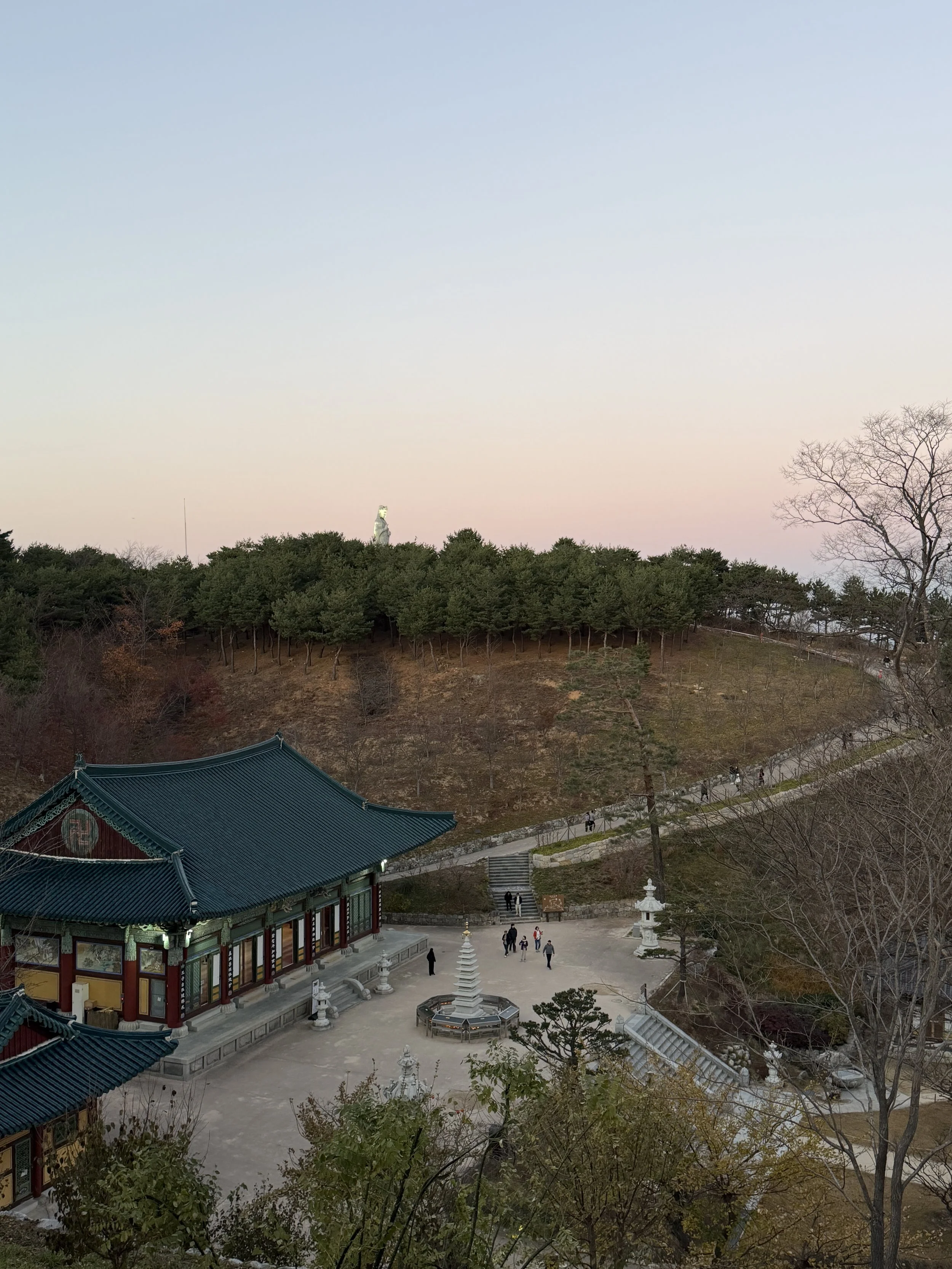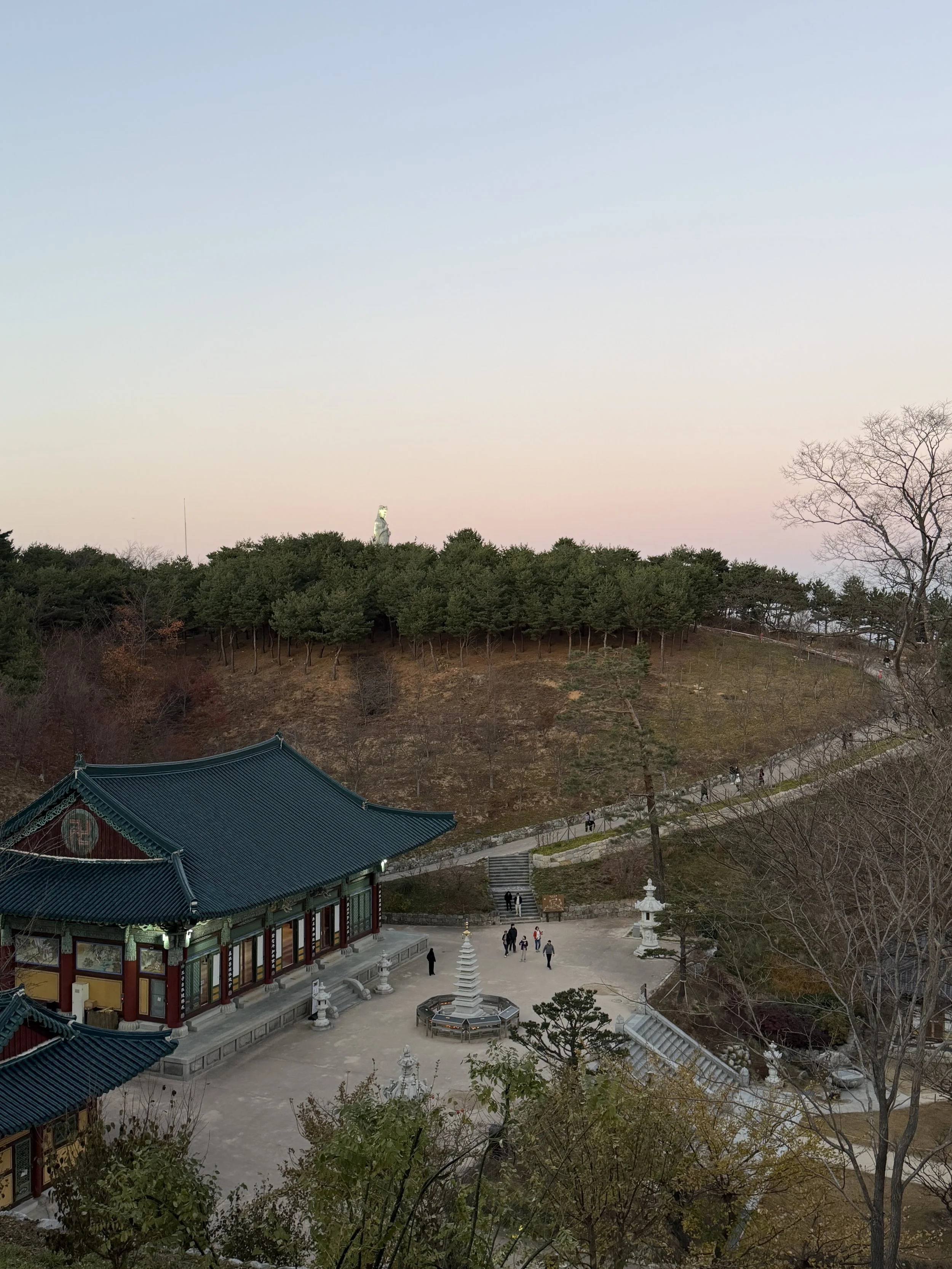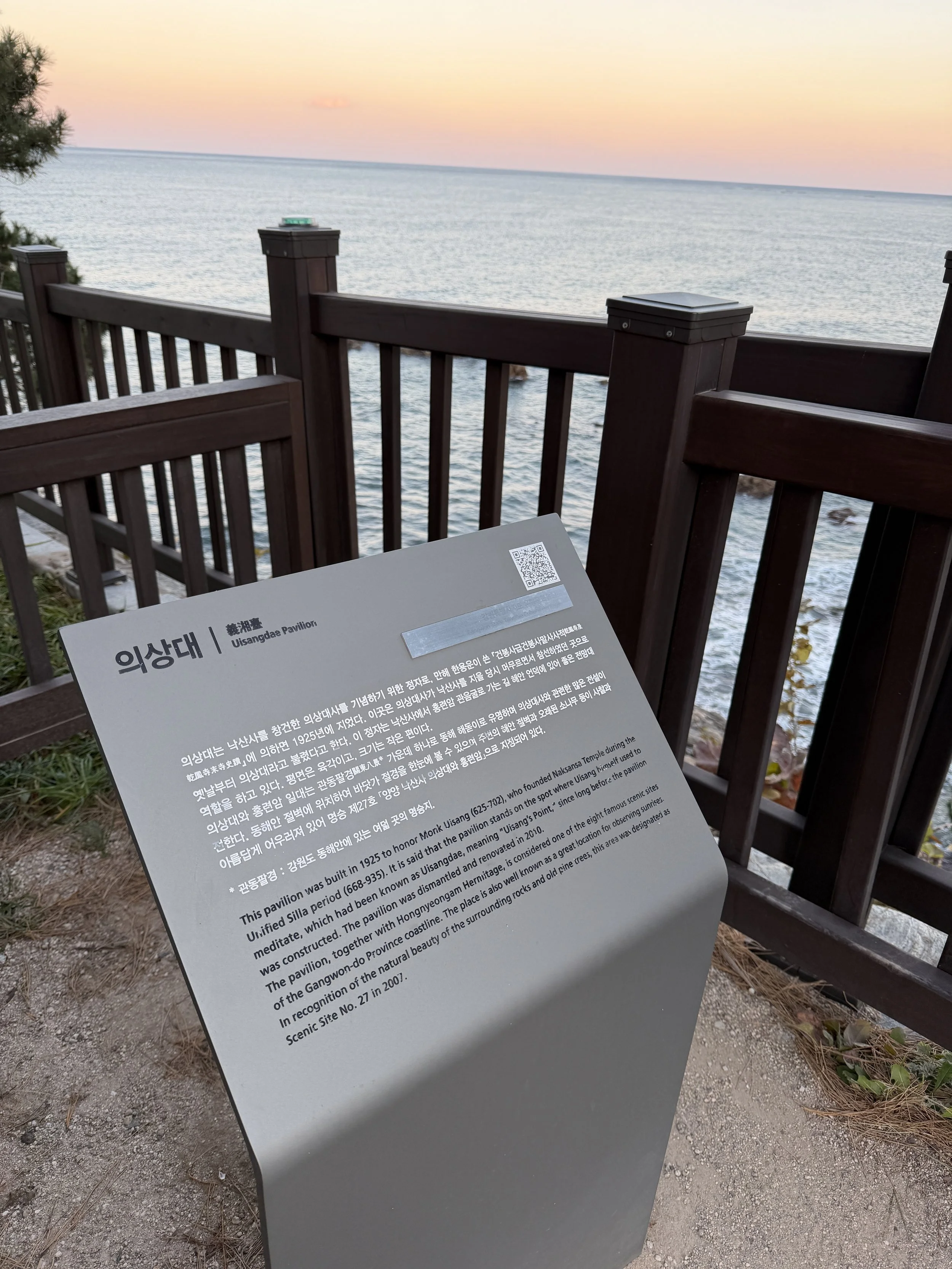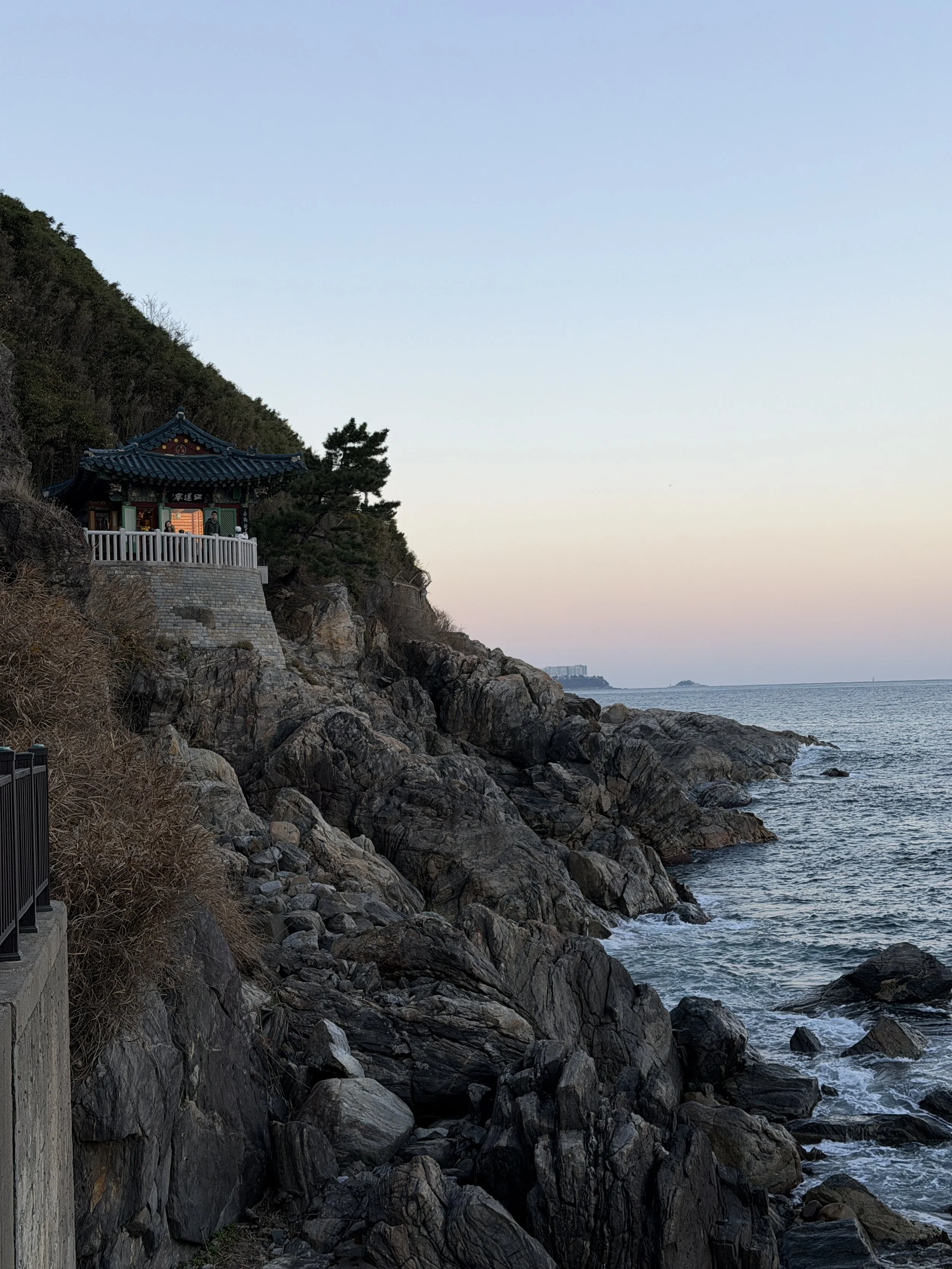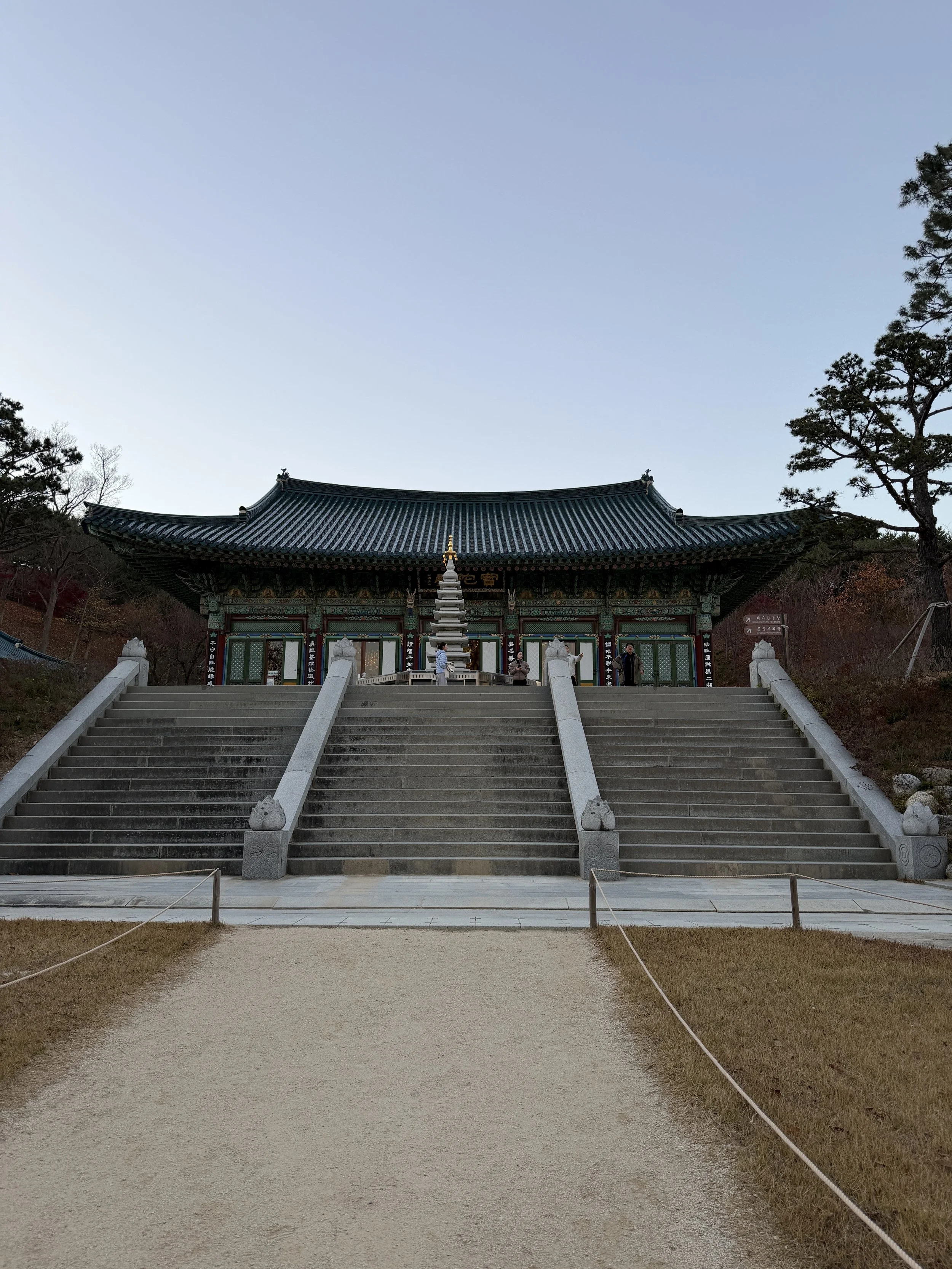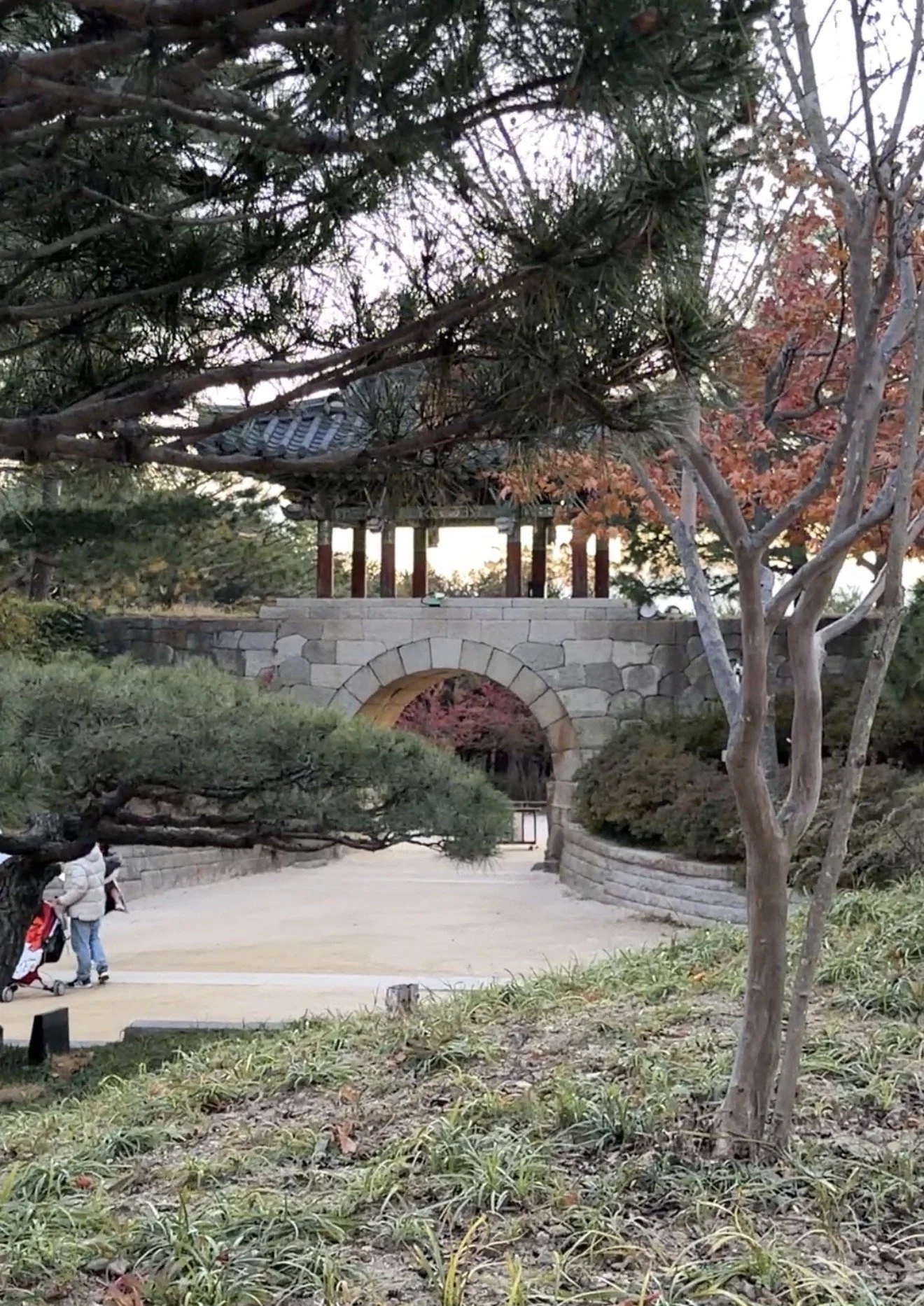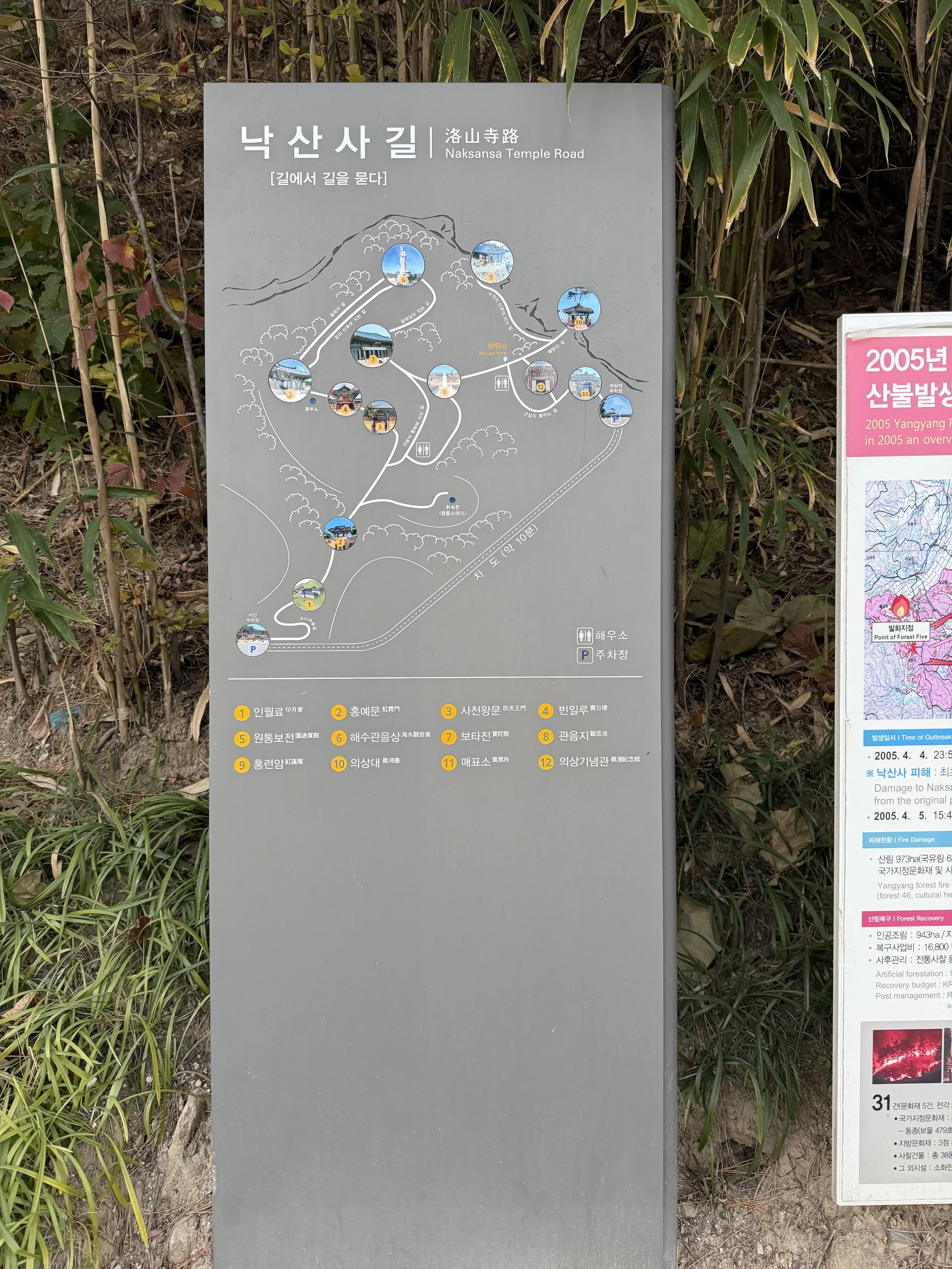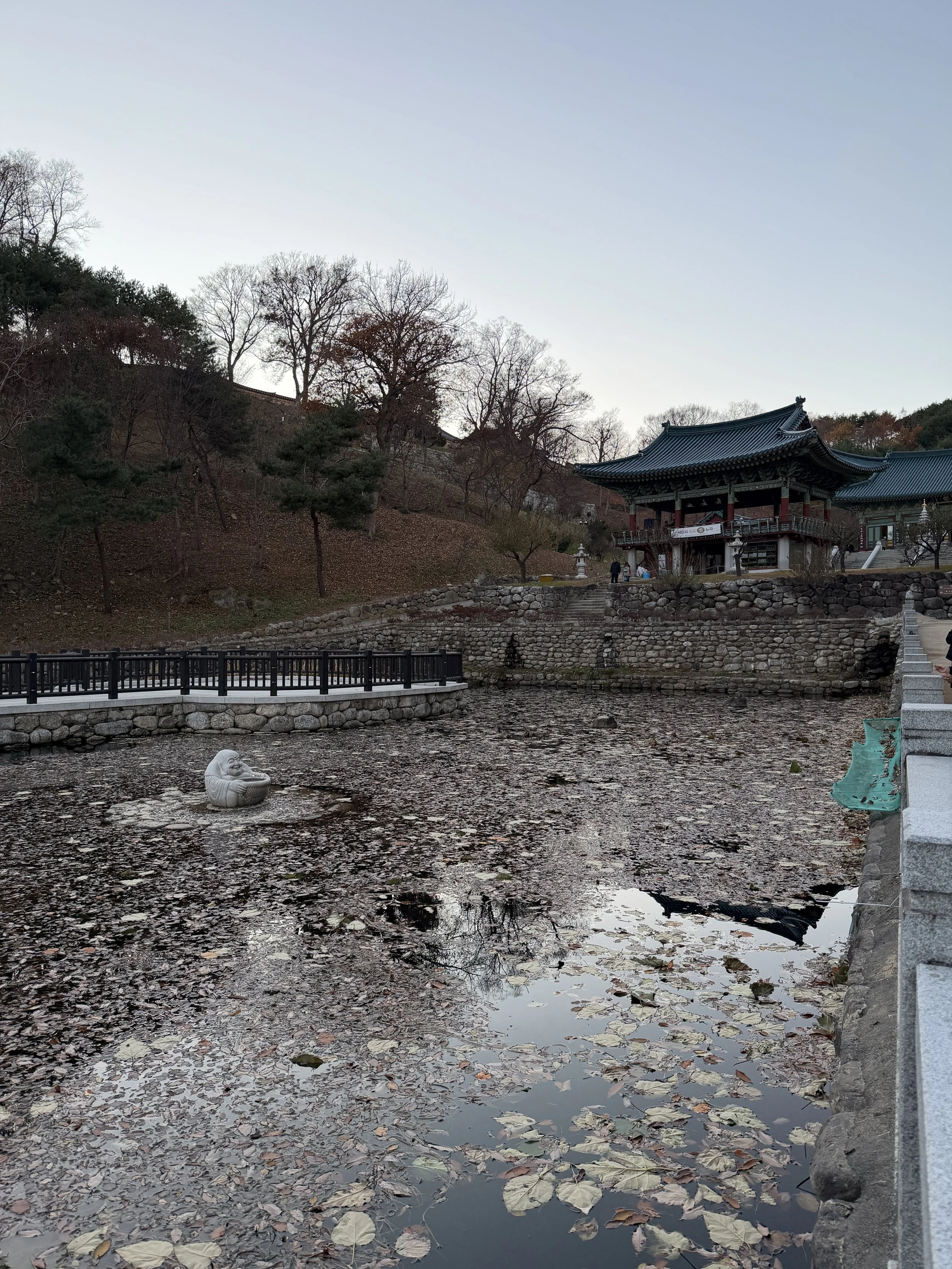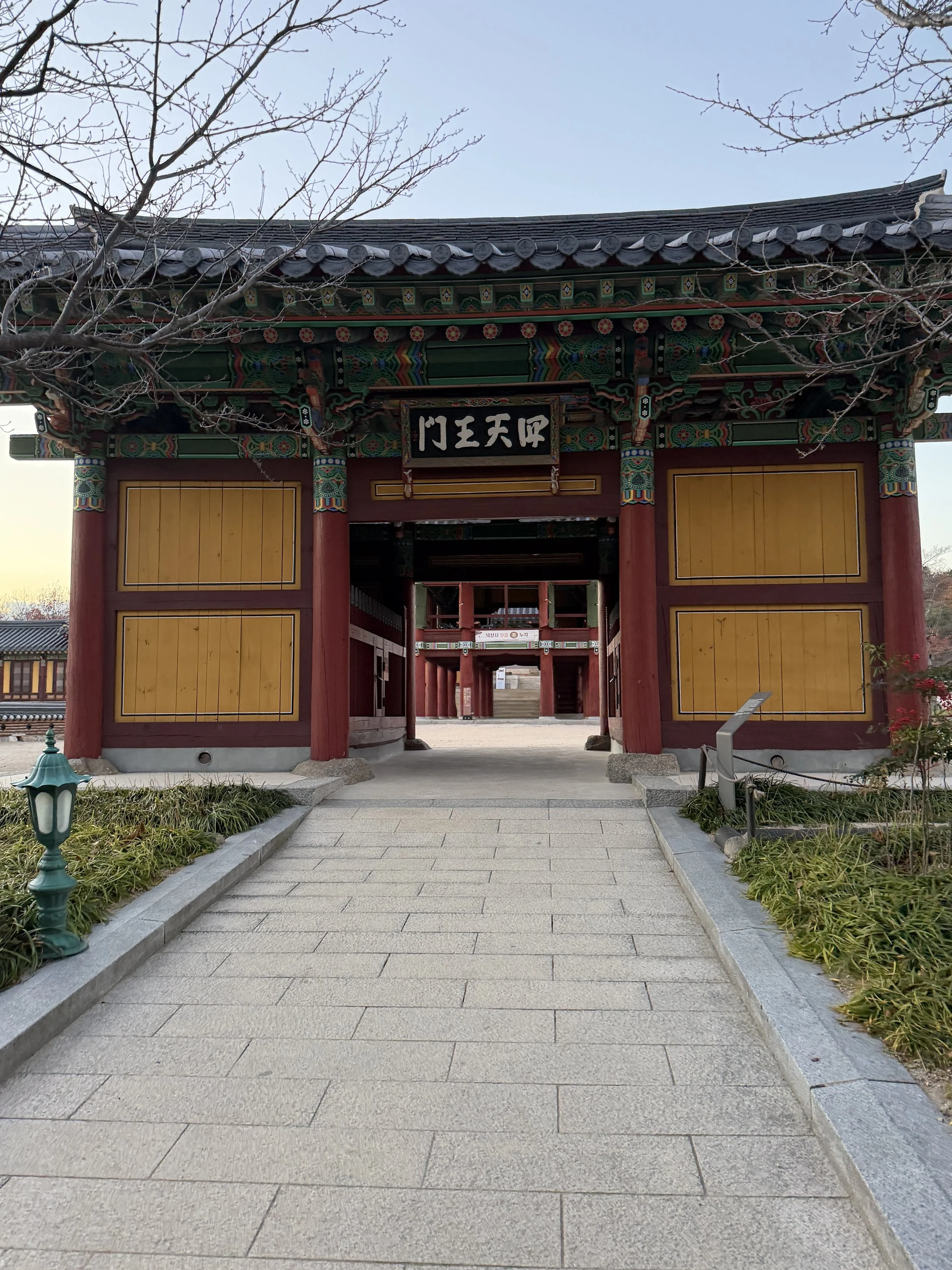Around Korea: Naksan Temple (낙산사) in Yangyang
Located on the cliffside of the East Sea sits Naksan Temple, also known as Naksansa (낙산사). (In Korean, the suffix –sa means “temple,” so the names are often used interchangeably.)
I recently had the chance to visit Naksan Temple at dusk and it was absolutely breathtaking. Perched high on the cliffs above the East Sea, the temple glowed in soft golden light as the sky shifted into pastel blues and pinks. The sound of waves below, the calm breeze, and the silhouettes of temple rooftops made it one of the most beautiful and peaceful moments of my trip.
History of Naksansa Temple
Naksansa is breathtaking, but its roots run deep. The temple was founded in 671 CE during the Silla Dynasty by the monk Uisang.
Legend has it that Uisang meditated for days on a seaside cliff, seeking Avalokiteśvara (the Bodhisattva of Compassion). In one version of the story, he was about to leap into the sea, but then saw a vision of the Bodhisattva, who gave him a crystal rosary and directed him to build a temple. That moment became the spiritual foundation of Naksansa, which is named after Mount Potalaka (“Botarakgasan”), believed in Buddhist lore to be the Bodhisattva’s mythical home.
Over the centuries, Naksansa has been destroyed and rebuilt multiple times — by fire, war, and natural disasters. For instance, a devastating wildfire in April 2005 destroyed about 20 buildings, including the temple’s historic bronze bell, which had been a national treasure. The result: many of the current structures date from restorations completed in the years since.
A Rare Coastal Temple
Cliffside view from Naksansa Temple overlooking the East Sea near Yangyang
While many Buddhist temples in Korea are tucked into mountains or forested valleys, Naksan Temple is one of the few built directly along the coastline. Perched on the cliffs above the East Sea, the temple complex was designed to overlook the water - a location that has shaped its character, mythology, and the unforgettable views visitors come to see.
This unique placement is part of what makes a visit here feel so immersive — the spiritual energy blends seamlessly with the natural landscape.
The 16-Meter Tall Statue Haesugwaneumsang
At dusk, the statue seems to glow — a moment that completely stopped me in my tracks.
One of the most iconic features of Naksansa is the 16-meter-tall statue of Gwanseum-bosal (Avalokiteśvara), also called Haesugwaneumsang (해수관음입상). One of Naksansa’s most iconic features is the 16-meter Haesugwaneumsang, a towering statue of Gwanseum-bosal facing out toward the East Sea. The white granite figure stands on a 2.8-meter pedestal, making it visible from across the temple grounds. The current statue dates to 1977 and was constructed over about six months.
As the sun dipped below the horizon, the statue caught the last light of day and almost appeared illuminated. It was one of those rare moments that feels suspended in time — humbling, quiet, unforgettable. I hadn’t realized how striking it would be in person, and the sight of it genuinely stunned me.
Architectural Highlights
Uisangdae Pavilion
Uisangdae Pavilion marks where the monk Uisang meditated and founded the temple over a thousand years ago.
A small pavilion perched atop a cliff where Uisang is said to have meditated. The panoramic ocean views here are some of the best in the region.
Hongnyeonam Hermitage
One of the few Buddhist temples built directly on the coast, offering stunning sunset views of the East Sea.
Built right on the cliff’s edge, this hermitage lets you hear the waves crash below — especially magical during sunrise or sunset.
Coastal Walking Paths
The walking paths around the temple offer some of the best coastal views in Yangyang.
The paths that wind around the cliffs offer endless viewpoints, each one more stunning than the last.
Pagodas and Temple Halls
One of the many pavilions and pagodas.
Scattered throughout the complex, these historic structures represent centuries of Buddhist culture and craftsmanship. Inside the temple grounds, there’s a seven-story pagoda that dates back centuries - a quiet, elegant reminder of the temple’s long Buddhist lineage.
Bronze Bell
The original, cast in the 15th century, was melted in the 2005 fire. A replica now stands in its place.
The Spiritual & Sensory Experience
Entering Naksansa Temple at the Hongyemun Gate — one of Korea’s most beautiful coastal temples overlooking the East Sea.
Visiting Naksansa at dusk was more than just a visual treat — it felt like a moment of spiritual pause. The salt air, the distant rhythms of the ocean, the ancient architecture silhouetted against the sky — all of it made me feel grounded. This isn't just a tourist spot; it's a place for reflection and connection.
Tips for Visiting Naksansa Temple
Map of Nasksansa grounds.
Best time to visit: Sunset (dusk adds a gorgeous glow over the sea).
Travel time: 1–2 hours is plenty, but you may want more for photos.
Accessibility: Most paths are paved, though some sections include stairs.
Parking: A large paid parking lot is available near the entrance.
Photos: Don’t miss the shot overlooking the temple rooftops with the East Sea in the background.
Naksansa is more than its breathtaking views. It’s a living symbol of resilience (having survived fire and reconstruction), devotion (as a center for Avalokiteśvara worship), and harmony (blending nature, sea, and sacred architecture).
How to Get to Naksansa Temple
Botajeon Hall at Naksansa Temple overlooking a lotus pond in late November
Getting to Naksansa Temple is straightforward whether you’re driving yourself or joining a tour. There’s plenty of parking available near the entrance, and the roads from Yangyang or Sokcho are easy to navigate. If you prefer not to drive, several guided tours run daily from both cities, offering an stress-free way to experience the temple and its stunning coastal views. These tours often combine visits to nearby beaches, markets, and scenic spots along the East Sea coast.
Gangneung: BTS Bus stop, K-Drama Goblin Filming Spot, Sheep and Naksana
FAQ: Visiting Naksansa Temple
Looking at the path through several buildings.
Is Naksansa Temple free to enter?
Naver claims there is a small fee of 3,000 per adult, however, entry was free when we visited. All signs currently up at the temple say “free entry” in Korean as well.
How long does it take to visit Naksansa?
Most visitors spend 1–2 hours, but if you’re walking the full coastal path, visiting the pavilions, and taking photos at the statue, plan for closer to two.
What is the big statue at Naksansa Temple?
That’s the 16-meter Haesugwaneumsang, a towering statue of the Bodhisattva of Compassion (Gwanseum-bosal) overlooking the East Sea.
Can you see the sunset from Naksansa?
Yes — and it’s one of the best times to go. The soft golden light makes the cliffs, temple buildings, and statue glow.
Is Naksansa Temple family-friendly?
Absolutely. The paths are well-maintained, there’s plenty of open space, and kids often love the ocean views and large statue.
How far is Naksansa from Yangyang and Sokcho?
It’s 5–10 minutes from Yangyang and about 20 minutes from Sokcho, making it an easy stop from either destination.
For anyone exploring Yangyang or the popular beach and market areas of Sokcho, Naksansa Temple is an easy and meaningful addition to your trip. Its rare coastal setting, sweeping East Sea views, and iconic 16-meter statue make it one of the most memorable attractions in Gangwon State.

